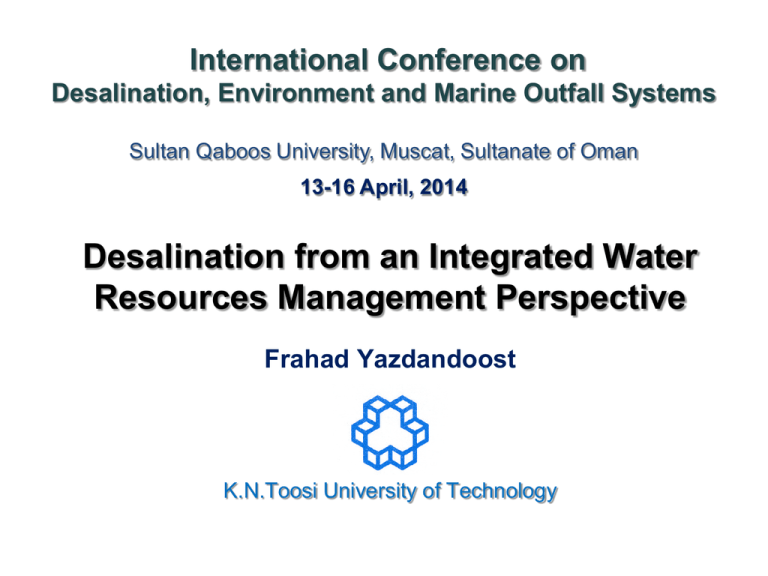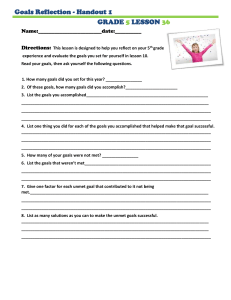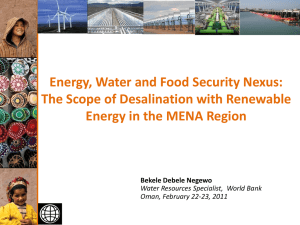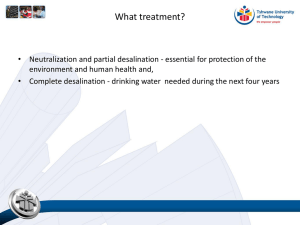Desalination from an Integrated Water Resources Management Perspective International Conference on
advertisement

International Conference on Desalination, Environment and Marine Outfall Systems Sultan Qaboos University, Muscat, Sultanate of Oman 13-16 April, 2014 Desalination from an Integrated Water Resources Management Perspective Frahad Yazdandoost K.N.Toosi University of Technology Global Water Challenges More than a billion people lack access to safe water supplies Almost three billion do not have access to adequate sanitation Five to ten million people die each year from water-related diseases or inadequate sanitation Twenty percent of the world's irrigated lands are salt-laden, affecting crop production World Population World Population World Population Distribution Fresh Water Availability Global Water Consumption Annual Available Water Resources Source: Wangnick 2004 Water Scarcity Fresh Water Availability 1950 1995 2025 X 1000 m3 per capita Fresh Water Availability Global distribution 15% 8% 13%MENA 36% 8% 60% 11% 13% 26% 6% 5% 1% Approximate percentage of global population Approximate percentage of global water supply Water Crises in the MENA Region (Middle East and North Africa) Population of the MENA region = 5% of the world population Freshwater availability in the MENA region= 1% of the global freshwater it is expected that water availability per capita will decrease to the present situation during the next 30 years ½ of Water Crises in the MENA Region Irrigation with the proportion of 87% is the biggest consumer with low efficiency; Up to 50% of the municipal water is wasted in the distribution systems; (World Bank, 1995) Groundwater is the most important resource; 60% of the desalinisation plants of the world are installed in this region. MENA has the lowest per capita water resources worldwide…it’s dwindling fast! Australia & New Zealand Latin America & Caribbean North America Europe & Central Asia Sub-Saharan Africa East Asia & Pacific (incl. Japan&Koreas) Western Europe South Asia Middle East & North Africa 0 10 20 30 40 1000 m^3 / year Annual renewable water resources per capita Source: FAO AQUASTAT (2007) a) Average annual renewable water resources for MENA (2007) was 1,200 m3/capita, compared to 7,000 m3/capita globally.. b) 14 out of the top 20 Water Scarce Countries are in MENA c) Water scarcity will become a challenge to growth …today’s water deficit in MENA is met by overexploitation of groundwater and—to a lesser degree—by fossil-fuelled desalination, but this is not sustainable… Groundwater Desalination potential is on the rise in MENA Forecasted Desalination Capacity (20082016), 12 MENA countries are in the TOP 20 globally. .. and the trend is projected to continue beyond 2016 with more MENA countries coming into picture, especially Egypt source: GWI (2008) Desalinated Water as share of municipal and industrial water supply Percentage of M&I water supply Turkey Morocco Iran Egypt Gaza Jordan Tunesia Israel Algeria Yemen Cyprus Saudi Arabia Oman Malta Bahrain UAE Qatar Kuwait 0 20 % 40 % 60 % 80 % Source: A. Macoun 100 % Sea water desalination capacity in the world Seawater desalination capacity in the Middle East Online desalination technology capacity in the Gulf Cooperation Council (GCC) and worldwide 2012 Source: Saif, 2012 22 Global Warming 1995-2004 Mean Temperatures Climate Change is effecting our environment, our societies and our cultures What does the future hold…..? WATER: • Water deficit is projected to increase from 50 BCM per year today to 150- to 235 BCM per year by 2050, based on the level of water use efficiency and wastewater reuse adopted, 2/3 times the physical volume of the Nile River flow…scary! ENERGY: • Correspondingly, about 31 billion barrels of fuel is needed to desalinate about 150 BCM of water per year by 2050 (e.g., KSA today uses > 1.5 million bbls/day for desal)…not sustainable Environmental impacts/GHG Emissions: • Which corresponds to 9.6 GtC (gigatonnes of carbon) of CO2 emissions per year by 2050….not sustainable (global good) And food security…? • • 60 % of food from irrigated agr. (21 Mha, consuming 251BCM+) In some areas, fossil groundwater is being exploited for irrigation…not sustainable…rainfed plays a good role but threatened by Climate Change. The Nexus approach Water has moved from a marginal input towards a central enabler of food, energy and climate security – and a vital prerequisite for growth. Sustainability Sustainable development means meeting the needs of people along with saving the natural resources for next generations WEF Security means that in all over the world people should have the physical and economical access to all the resources to meet their needs water, energy and food security can be achieved through a Nexus approach – an approach that integrates management and governance across sectors and scales Sustainable life Sustainable development water, energy and food security WEF NEXUS Water WEF NEXUS Food Energy Food production is responsible for around 30 % of total global energy demand. Crops can themselves be used to produce bio-fuels. WEF Nexus & Desalination • Desalination is one of the biggest energy users in the world (about 1 ton of oil is required for every 20 tons of freshwater produced even if all the heat can be extracted from the oil) • Over the last 50 years Fossil fuels account for the most of energy which is being used in such process • Depletion of fossil fuels, air pollution and greenhouse gases emission are desalination consequences • These pollutants will make changes in ecosystems, destroy some kinds of animals or plants or change their normal existence as a part of the food chain. Steps in desalination to approach Nexus Renewable energies Energy-Water Nexus Hybridization WEF Nexus & Desalination Concentrate discharge Food-Water Nexus Water intakes Desalination & Renewable Energies Renewable Energies Solar Solar Geothermal Wave Wind Wave Geothermal • Solar RV & VC Direct Magma • Stills Coastal Areas Buoy WindUnder • wind-wave hybrid system • Coastal areas , mountainResearch stations & islands connected toThermal a distiller(Heath) storage is Geopressurized • RO & MVC energy •unnecessary Solar ponds Solar • Cost Effective Indirect • Photovoltaic modules Collectors Oscillating Electricity • PV thermal collectors Mature water column Distillation & RO generation Hybridization Salinity Temperature Chemicals Will effect marine organisms such as population, size and behavior Result in lower DO Eutrophication by Antiscalants concentrations of greater than 5% are Harmful for marine life Effects the mobile species Ionized and unionized species Decrease the time of the eggs development Bury sessile benthic organisms Increasing the rate of the population growth Water Intakes • According to EPA, these intake structures kill at least 3.4 billion fish and other organisms annually. Larger organisms are trapped against the intake screens, and smaller ones, such as fish eggs and larvae, are drawn through the intake screens and destroyed in the cooling system. • Re-suspension of sediments, Pollutants, Nutrients during construction will change the marine life. Integrated Water Resources Management Supply Oriented Mono-Sectoral Approach IWRM A paradigm shift Demand Oriented Multi-Sectoral Approach IWRM is a process which promotes the co-ordinated development and management of water, land and related resources, in order to maximize the resultant economic and social welfare in an equitable manner without compromising the sustainability of vital ecosystems (GWP 2000). CHANGE AREAS CHANGES ARE MADE TO SEEK Economic Efficiency Social Equity TO REACH SUSTAINABILITY Environmental Sustainability IWRM Concepts: Impacts Demands Natural Resources System Socio-Economic System IWRM Infrastructure Institutional System Laws, Regulations, Management IWRM Water footprint per capita 3000 Domestic water consumption Industrial goods Agricultural goods 2000 3 Water footprint (m /cap/yr) 2500 1500 Global average water footprint 1000 500 USA Italy Thailand Nigeria Russia Mexico Brazil Indonesia Pakistan Japan India China 0 [Hoekstra & Chapagain, 2008] National virtual water balances Net virtual water import (Gm3/yr) -100 - -50 -50 - -25 -25 - -10 -10 - -5 -5 - 0 0- 5 5 - 25 25 - 50 50 - 100 No Data [Hoekstra & Chapagain, 2008] Regional virtual water balances (only agricultural trade) Arrows show trade flows >10 Gm3/yr [Hoekstra & Chapagain, 2008] Virtual Water 26 73 1 bath baths 1260 litres 22,000 2 litres/m 7,500 litres/kg 560 litres/g IRAN Area: Population: No of provinces: Average Rainfall: 1.648 million km2 77 million 31 271 mm Neighboring Countries: Afghanistan, Pakistan, Iraq Turkmenistan, Azerbaijan, Armenia, Turkey Arab States in Persian Gulf Language: Persian, Azerbaijani, Kurdish, … Population growth 1961 24. 3 Unit: Million inhabitants Population growth 2001 66. 0 1961 24. 3 Unit: Million inhabitants Population growth 2021 1 00 2001 66. 0 1961 24. 3 Unit: Million inhabitants Water Resources Water Resources Source of Water Volume (BCM) precipitation 412 evapotranspiration 282 renewable water resources 130 recharge of groundwater resources by precipitation and surface flows 38 available surface flows 92 Year Annual Renewable Water availability (cubic meters/capita) 1956 7000 2001 2000 2021 1300 Lake Urmia The Hamoun Case of Kashan KASHAN KASHAN • • • • • • • • Dry zone in Central IRAN plateau Rich culture Historical background Hotspot for tourism industry Production of the finest Rosewater Renowned Persian carpets Water resources limitations Excessive pressures on groundwater resources Application of the Toolbox Sources and Demands Main Demands,2006(MCM) Water supply volumes in 2006(MCM/Year) Drinking water Industry Agriculture Ground water Surface water Golab tunnel 33.98 5.89 387.29 314.13 29.55 6 • 90 % of water demand in agriculture • 8% for drinking and 2 % for industry • compared to the total supply available there is no balance between supply and demand in the region. • No noticeable permanent rivers • Extreme pressure on groundwater • An average loss of approximately 0.5 meter in Kashan aquifer annually • Inter basin water transfer Main Criteria and Scenario Development Generate scenarios: 1. Allocation priority 2. Agriculture conditions 3. Rate of population growth 4. Demand Management (reducing consumption per capita) 5. Wastewater reuse and loss management 6. Increasing the amount of transferred water through Golab tunnel 7. Changes in the Industry sector Multi-Criteria Decision-Making Resulting scenarios were considered individually as well as in overlapping formats to evaluate their rankings using MCDM approach based on both quantitative and nonquantitative criteria upon which implementation measures may be deducted and adopted. Results Weight effects based on unmet demand, Definite 2 MCA4 MCA3 MCA2 MCA1 Order Agriculture Unmet demand Drinking water Unmet demand Drinking water Unmet demand Drinking water and Industry Unmet demand 1 Drinking water and Industry Unmet demand Agriculture Unmet demand Industry Unmet demand Agriculture Unmet demand 2 - Industry Unmet demand Agriculture Unmet demand - 3 Results Results Comparison of Scenarios Ranking Results Scenarios ranking for unmet demand in 2041(MCM) Results Scenarios combinations ranking in 2041(MCM) Conclusions Integrated water resources management approach is needed to ascertain sustainability Development of an IWRM toolbox facilitates appropriate decision making Individual approaches such as demand management, wastewater reuse, loss management, industrial water demand management and inter-basin water transfer through desalination should be investigated in integration to generate a multi scenarios situation based on varying priorities of water use Lake Urmia The Hamouns




